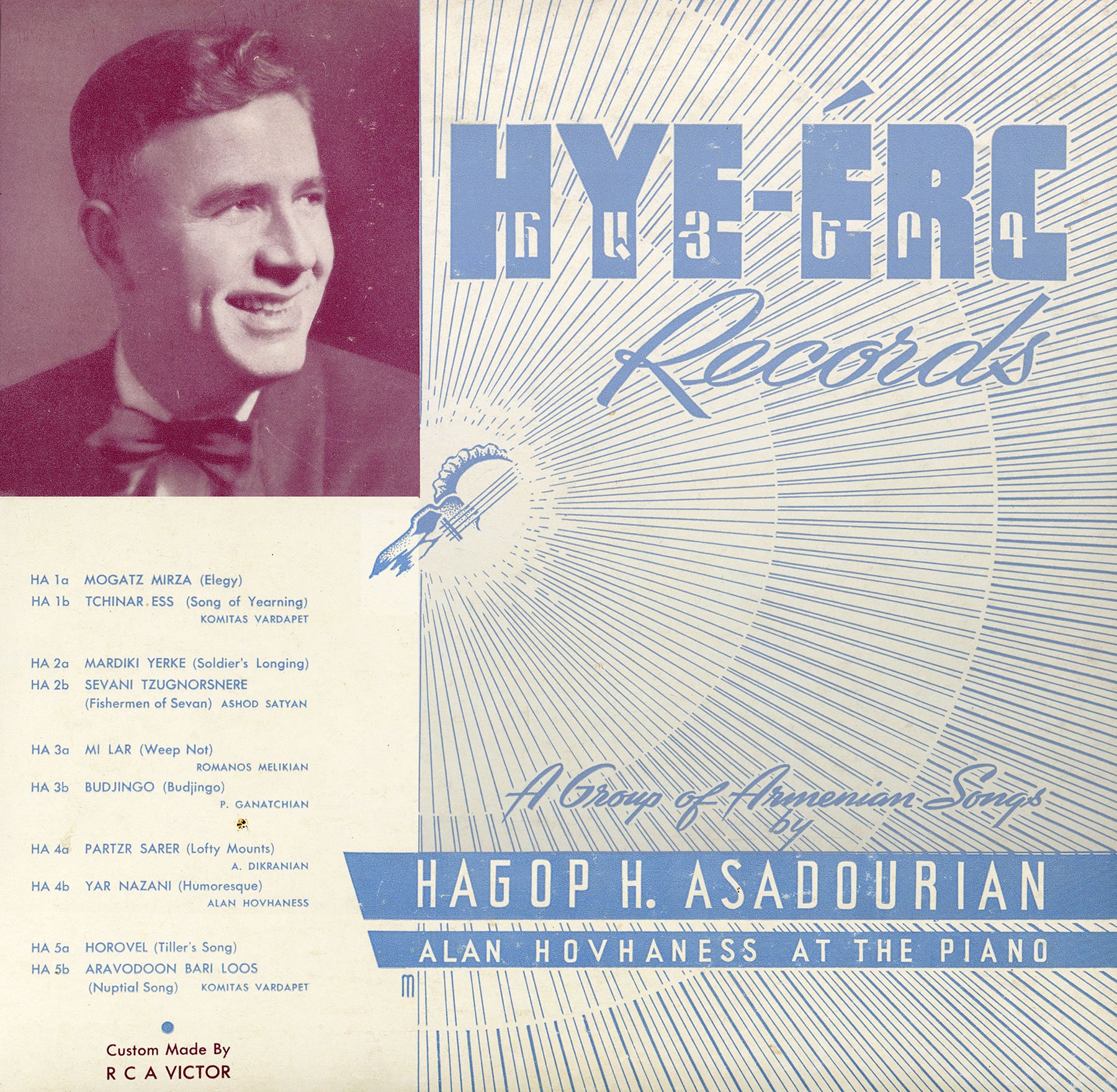Hagop Asadourian: Songs of Humor, Pathos, Tears, and Laughter
Written by Harout Arakelian
Over the years, the Sound Archive has attempted to detail the interconnectedness of the Armenian-American musical community. This installment highlights a significant contributor to the history of Armenians in America: Hagop H. Asadourian and his collaboration with Alan Hovhaness on record and in concert.
A survivor of the Armenian Genocide, Hagop Asadourian was born in the Armenian-speaking village of Chomaklou on March 3, 1903. He documented his harrowing story of surviving the Genocide through his literary works, particularly the book The Grandchildren of Hovagim, which documents his fight for survival. Arriving in the United States as a teenager in 1920, Asadourian made an initial attempt to enter the literary world by becoming the editor for the Chomaklou Society’s publication Aegos. Asadourian briefly enrolled at Columbia University in 1928, but the Great Depression of 1929 forced him into a different direction. He moved to Detroit, Michigan, and established a very successful Oriental rug business; in 1933, he opened a location in New York City named the Asadourian Rug Co. By the 1940s, Asadourian’s literary career began to take flight, and he published a collection of poems titled Antasdan, published in Boston in 1946. Throughout his literary career, he would publish numerous books, notably Komitas Vardapet and the Armenian Song (1962) and The Grandchildren of Hovagim (1965).
Not only a successful rug merchant and writer, Asadourian was a talented tenor vocalist. In 1949, he released a 10-song set of 78 rpm records for his label Hye-Erc Records. Alan Hovhaness accompanies him on all 10 songs. The liner notes written by Asadourian explain the production:
“This album aims to present the various aspects of Armenian music in a group of melodies depicting love, sorrow, longing, humor, and eulogy.
Records No. 1 and No. 5 represent Armenian folk songs compiled and harmonized by Komitas Vardapet -- the talented exponent of the Armenian musical style. The three others comprise the works of contemporary composers, some depicting in their mode of expression a distinct Armenian musical heritage, and the others a decided influence of Western musical technique in harmony and general composition.”
The album set was dedicated to musicologist Mihran Toumadjan. During the late 1940s, Toumadjan was the music director of the Armenian National Chorus. For a historic concert on April 24, 1949, Toumadjan invited both Hagop Asadourian and Alan Hovhaness to be a part of an event at the Town Hall venue in New York City.
For the selection of songs included in the album set, Asadourian utilized compositions by an assortment of composers, with works by Satyan, Melikian, Ganatchian, Dikranian, two works by Komitas Vardapet, as well as one work by Alan Hovhaness, Yar Nazani. The song was published in 1938 and was a rare coproduction by Hovhaness, who arranged the music, while the lyrics were written by the Armenian short story writer Hamasdegh (H. Gelanian). In the liner notes, Asadourian describes the song as such:
“YAR NAZANI (Humoresque): A lively song, mingled with humor and pathos. A young man takes his father's only goat to the market and exchanges it with a saz (mandolin) to serenade his maiden. Discovering this the following day, his father, in rage, smashes the saz to pieces.”
We have included an additional three songs to accompany this article and rely on Hagop Asadourian’s own writing to describe each song:
SEVANI TZUGNORSNERE (Fishermen of Sevan): The fishermen of the mountain lake, Sevan, in a retiring mood, meditate over the various phases of a fisherman's life,-tears and laughter in endless succession. This song is written after the style characteristic to Armenian troubadours.
BUDJINGO: A love song, a rustic poem, written in simple yet delightfully effective similies derived from nature.
ARAVODOON BARI LOOS (Nuptial Song) : The procession of merry-makers on their way from the church wedding to the home of the wedlocked. The steady beat of the drum forms a characteristic adjunct to the conviviality of the singers.
While his commercial recordings were limited to these sessions with Alan Hovhaness, Asadourian continued performing at special events. While he’s most remembered for his literary work, in 1984 and 1989, filmmaker and documentarian J. Michael Hagopian interviewed Asadourian. The video is available for viewing via the USC Shoah Foundation’s website.
Album cover for Hagop H. Asadourian’s 1949 record box set on Hye-Erc Records label. (Image scan: The Mesrob G. Boyajian Library)
A special thanks to the SJS Charitable Trust for their generous support of our work to digitize and share our collection of 78 rpm records.


